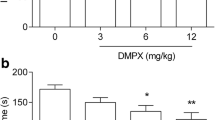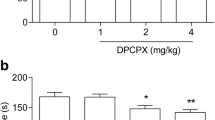Abstract
Background
It has recently been suggested that the adenosine A2A receptor plays a role in several animal models of depression. Additionally, A2A antagonists have reversed behavioral deficits and exhibited a profile similar to classical antidepressants.
Methods
In the present study, imidazo- and pyrimido[2,1-f]purinedione derivatives (KD 66, KD 167, KD 206) with affinity to A2A receptors but poor A1 affinity were evaluated for their antidepressant- and anxiolytic-like activity. The activity of these derivatives was tested using a tail suspension and forced swim test, two widely-used behavioral paradigms for the evaluation of antidepressant-like activity. In turn, the anxiolytic activity was evaluated using the four-plate test.
Results
The results showed the antidepressant-like activity of pyrimido- and imidazopurinedione derivatives (i.e. KD 66, KD 167 and KD 206) in acute and chronic behavioral tests in mice. KD 66 revealed an anxiolytic-like effect, while KD 167 increased anxiety behaviors. KD 206 had no effect on anxiety. Furthermore, none of the tested compounds increased locomotor activity.
Conclusion
Available data support the proposition that the examined compounds with adenosine A2A receptor affinity may be an interesting target for the development of antidepressant and/or anxiolytic agents.
Similar content being viewed by others
References
Gubitz AK, Widdowson L, Kurokawa M, Kirkpatrick KA, Richardsonn PJ. Dual signalling by the adenosine A2A receptor involves activation of both N- and P-type calcium channels by different G proteins and protein kinases in the same striatal nerve terminals. J Neurochem 1996;67:374–81.
Svenningsson P, Le Moine C, Fisone G, Fredholm BB. Distribution, biochemistry and function of striatal adenosine A2A receptors. Prog Neurobiol 1999;59:355–96.
Boison D, Chen J-F, Fredholm BB. Adenosine signaling and function in glial cells. Cell Death Differ 2010;17:1071–82.
Ongini E, Fredholm BB. Pharmacology of adenosine A2A receptors. Trends Pharmacol Sci 1996; 17:364–72.
Sarges R, Howard HR, Browne RG, Lebel LA, Seymour PA, Koe BK. 4-Amino [1,2,4]triazolo[4,3-a]quinoxalines: a novel class of potent adenosine receptor antagonists and potential rapid-onset antidepressants. J Med Chem 1990;33:2240–54.
El Yacoubi M, Ledent C, Parmentier M, Bertorelli R, Ongini W, Costentin J, et al. Adenosine A2A receptor antagonists are potential antidepressants: evidence based on pharmacology and A2A receptor knockout mice. Br J Pharmacol 2001;134:68–77.
El Yacoubi M, Costentin J, Vaugeois JM. Adenosine A2A receptors and depression. Neurology 2003;61(11 Suppl. 6):S82–7.
Hodgson RA, Bertorelli R, Varty GB, Lachowicz JE, Forlani A, Fredduzzi S, et al. Characterization of the potent and highly selective A2A receptor antagonists preladenant and SCH 412348 [7-[2-[4-2,4-difluorophenyl]-1-piperazinyl] ethyl]-2-(2-furanyl)-7H-pyrazolo[4,3-e][1,2,4]triazolo[1,5-c]pyrimidin-5-amine] in rodent models of movement disorders and depression. J Pharmacol Exp Therap 2009;330:294–303.
Yamada K, Kobayashi M, Shiozaki S, Ohta T, Mori A, Jenner P, et al. Antidepressant activity of the adenosine A2A receptor antagonist, istradefylline (KW-6002) on learned helplessness in rats. Psychopharmacology 2014;231:2839–49.
Hart EE, Conoscenti MA, Minor TR. Animal model of depresion: a focus on adenosine signaling at A2A receptors. Ann Depress Anxiety 2014;1:1–9.
Minor TR, Hanff TC. Adenosine signaling in reserpine-induced depression in rats. Behav Brain Res 2015;286:184–91.
Wardas J, KoniecznyJ, Lorenc-Koci E. SCH 58261, an A(2A) adenosine receptor antagonist, counteracts parkinsonian-like muscle rigidity in rats. Synapse 2001;41:160–71.
Yamada K, Kobayashi M, Mori A, Jenner P, Kanda T. Antidepressant-like activity of the adenosine A(2A) receptor antagonist, istradefylline (KW-6002), in the forced swim test and the tail suspension test in rodents. Pharmacol Biochem Behav 2013;114–115:23–30.
Mizuno Y, Kondo T. Adenosine A2A receptor antagonist istradefylline reduces daily OFF time in Parkinson’s disease. Mov Disord 2013;28:1138–41.
Kaster MP, Machadoa NJ, Silva HB, Nunesa A, Ardais AP, Santanaa M, et al. Caffeine acts through neuronal adenosine A2A receptors to prevent mood and memory dysfunction triggered by chronic stress. PNAS 2015;112:7833–8.
Hascoët M, Bourin M, Colombel MC, Fiocco AJ, Baker GB. Anxiolytic-like effects of antidepressants after acute administration in a four-plate test in mice. Pharmacol Biochem Behav 2000;65:339–44.
Borsini F, Podhorna J, Marazziti D. Do animal models of anxiety predict anxiolytic-like effects of antidepressants? Psychopharmacology 2002;163:121–41.
Kulkarni SK, Singh K, Bishnoi M. Comparative behavioural profile of newer antianxiety drugs on different mazes. Indian J Exp Biol 2008;65:633–8.
Correa M, Font L. Is there a major role for adenosine A2A receptors in anxiety. Front Biosc 2008; 1:4058–70.
Deckert JA. The adenosine A(2A) receptor knockout mouse: a model for anxiety? IntJ Neuropsychopharmacol 1998;1:187–90.
Kieć-Kononowicz K, Drabczyńska A, Peękala E, Michalak B, Müller CE, Schumacher B, et al. New developments in A1 and A2 adenosine receptor antagonists. Pure Appl Chem 2001;73:1411–20.
Drabczyńska A, Müller CE, Karolak-Wojciechowska J, Schumacher B, Schiedel A, Yuzlenko O, et al. N9-benzyl-substituted 1,3-dimethyl- and 1,3-dipropyl-pyrimido[2,1-f]purinediones: synthesis and structure-activity relationships at adenosine A1 and A2A receptors. Bioorg Med Chem 2007;15:5003–17.
Drabczyńska A, Zygmunt M, Sapa J, Filipek B, Müller CE, Kieć-Kononowicz K. Antiparkinsonian effects of novel adenosine A2A receptor antagonists. Arch Pharm (Weinheim) 2011;344:20–7.
Zygmunt M, Gołembiowska K, Drabczyćska A, Kieć-Kononowicz K, Sapa J. Anti-inflammatory, antioxidant, and antiparkinsonian effects of adenosine A2A receptor antagonists. Pharmacol Biochem Behav 2015;132:71–8.
Cunha M, Pazini F, Rosa M, Ramos-Hryb A, Oliveira A, Kaster M, et al. Creatine, similarly to ketamine, affords antidepressant-like effects in the tail suspension test via adenosine A1 and A2A receptor activation. Purinerg Signal 2015;11:215–27.
Kaster M, Budni J, Gazal M, Cunha M, Santos ARS, Rodrigues ALS. The antidepressant-like effect of inosine in the FST is associated with both adenosine A1 and A2A receptors. Purinerg Signal 2013;9:481–6.
Drabczyńska A, Müller CE, Schiedel A, Schumacher B, Karolak-Wojciechowska J, Fruzinski A, et al. Phenylethyl-substituted pyrimido[2,1-f]purinediones and related compounds: structure-activity relationships as adenosine A1 and A2A receptor ligands. Bioorg Med Chem 2007;15:6956–74.
Drabczyńska A, Karcz T, Szymanska E, Köse M, Müller CE, Paskaleva M, et al. Synthesis, biological activity and molecular modelling studies of tricyclic alkylimidazo-, pyrimido- and diazepinopurinediones. Purinergic Signal 2013;9:395–414.
Koch P, Akkari R, Brunschweiger A, BorrmannT, Schlenk M, Küppers P, et al. 1,3-Dialkyl-substituted tetrahydropyrimido[1,2-f]purine-2,4-diones as multiple target drugs for the potential treatment of neurodegenerative diseases. Bioorg Med Chem 2013;21:7435–52.
Drabczyńska A, Müller CE, Lacher SK, Schumacher B, Karolak-Wojciechowska J, Nasal A, et al. Synthesis and biological activity of tricyclic aryloimidazo-, pyrimido-, and diazepinopurinediones. Bioorg Med Chem 2006;14:7258–81.
Drabczyńska A, Yuzlenko O, Köse M, Paskaleva M, Schiedel AC, Karolak-Wojciechowska J, et al. Synthesis and biological activity of tricyclic cycloalkylimidazo-, pyrimido- and diazepinopurinediones. Eur J Med Chem 2011;46:3590–607.
Eckstein M. Reaction of 8-chlorosubstituted theophylline with propylene oxide and epichlorhydrin; 2′,3′ -oxazolidine-7,8-theophyllne and its derivatives. Dissert Pharm 1962;14:425–35.
Steru L, Chermat R, Thierry B, Simon P. The tail suspension test: a new method for screening antidepressants in mice. Psychopharmacology (Berl) 1985;85:367–70.
Porsolt RD, Bertin A, Jalfre M. Behavioral despair in mice: a primary screening test for antidepressants. Arch Int Pharmacodyn Ther 1977;229:327–36.
Aron C, Simon P, Larousse C, Boissier JR. Evaluation of a rapid technique for detecting minor tranquilizers. Neuropharmacology 1971; 10:459–69.
Kulkarni SK, Dhir A. Effect of various classes of antidepressants in behavioral paradigms of despair. Prog Neuro Psychopharmacol Biol Psych 2007;31:1248–54.
El Yacoubi M, Ledent C, Menard JF, Parmentier M, Costentin J, Vaugeois JM. The stimulant effects of caffeine on locomotor behaviour in mice are mediated through its blockade of adenosine A(2A) receptors. Br J Pharmacol 2000;129:1465–73.
Yamada K, Kobayashi M, Kanda T. Involvement of adenosine A2A receptors in depression and anxiety. Int Rev Neurobiol 2014; 119:373–93.
El Yacoubi M, Ledent C, Parmentier M, Costentin J, Vaugeois JM. The anxiogenic-like effect of caffeine in two experimental procedures measuring anxiety in the mouse is not shared by selective A(2A) adenosine receptor antagonists. Psychopharmacology 2000;148:153–63.
Author information
Authors and Affiliations
Corresponding author
Rights and permissions
About this article
Cite this article
Dziubina, A., Szmyd, K., Zygmunt, M. et al. Evaluation of antidepressant-like and anxiolytic-like activity of purinedione-derivatives with affinity for adenosine A2A receptors in mice. Pharmacol. Rep 68, 1285–1292 (2016). https://doi.org/10.1016/j.pharep.2016.07.008
Received:
Revised:
Accepted:
Published:
Issue Date:
DOI: https://doi.org/10.1016/j.pharep.2016.07.008




